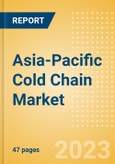Key Highlights
- Cold Chain involves transporting perishable products in a temperature-controlled supply chain. Supply chain often involves refrigerated production, storage, and distribution facilities. Perishable foods are often subjected to temperature fluctuations during transportation and handling, leading to food spoilage and waste. Cold Chain helps in reducing the spoilage of perishable products and ensure public health and safety, thus enabling the demand growth for refrigerated storage and transportation services worldwide. Refrigerated warehouse and cold transport are included in our market scope. Our scope doesn't include unorganized sector.
- The Asia-Pacific cold chain market had total revenues of $20.8 billion in 2022, representing a compound annual growth rate (CAGR) of 13.4% between 2017 and 2022.
- The fruits & vegetables segment accounted for market's the largest proportion in 2022, with total revenues of $9.6 billion, equivalent to 46.3% of the market's overall value.
- According to the Agricultural & Processed Food Products Export Development Authority (APEDA), during 2022-23, India exported fresh fruits & vegetables worth $1.6 billion.
Scope
- Save time carrying out entry-level research by identifying the size, growth, major segments, and leading players in the cold chain market in Asia-Pacific
- Use the Five Forces analysis to determine the competitive intensity and therefore attractiveness of the cold chain market in Asia-Pacific
- Leading company profiles reveal details of key cold chain market players' global operations and financial performance
- Add weight to presentations and pitches by understanding the future growth prospects of the Asia-Pacific cold chain market with five year forecasts
Reasons to Buy
- What was the size of the Asia-Pacific cold chain market by value in 2022?
- What will be the size of the Asia-Pacific cold chain market in 2027?
- What factors are affecting the strength of competition in the Asia-Pacific cold chain market?
- How has the market performed over the last five years?
- What are the main segments that make up Asia-Pacific's cold chain market?
Table of Contents
Companies Mentioned (Partial List)
A selection of companies mentioned in this report includes, but is not limited to:
- Nichirei Corporation
- AmeriCold Logistics LLC
- Konoike Transport Co., Ltd.
- SF Holdings Co Ltd








